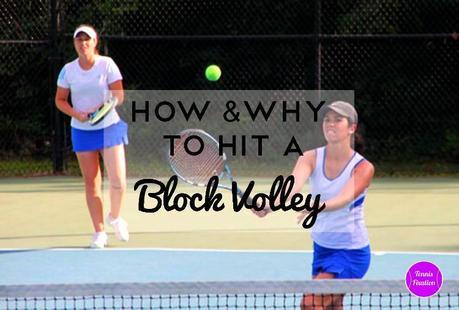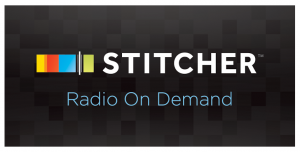Podcast: Play in new window | Download
The vast majority of volleys are effective when they are simply a block shot where you stick your racquet out and the ball bounces off of it. Why? Why is a block shot usually all that’s necessary to hit an effective volley? In this episode of Tennis Quick Tips, you’ll learn how and why to hit a block volley. You can listen to this episode by clicking on the media player above or by listening in with your favorite podcast app. You can also subscribe in iTunes by clicking on this link: tennisfixation.com/itunes.

SHOW NOTES:
While I am not a tennis pro, I do actually teach tennis. I teach young children who, for the most part, have never held a tennis racquet before. And most of the time, I’m just trying to keep them from getting hurt by swinging racquets or flying tennis balls.
Over the course of several weeks, I try to make sure my kids are at least familiar with four tennis strokes – the forehand, the backhand, the serve and the volley. I’m not saying they can do all four of these things by the end of our 10 lesson session, but at least they know what those strokes look like and they’ve made several attempts at hitting them.
By the time I teach these kids the volley, we’ve already done the forehand and backhand so their natural tendency is to want to swing to hit a volley. That’s what they had to do to hit a groundstroke so they think that’s what you do to hit all of your tennis strokes. But, in fact, an effective volley is often a situation where less is more. I think this is true with adults too because that’s what I see on the court a lot. Players swinging wildly and, often, ineffectively.
So, with my tennis kids, what I find myself trying to teach them about volleys is what NOT to do. Don’t swing at it. Don’t raise your racquet and don’t lower your racquet. Don’t wind up for a home run. And, whatever you do, don’t follow through and let your racquet touch or cross over the net.
Instead, when I try to teach the volley, I try to teach a simple block shot. And I think this is what most of us adult recreational players should often be doing on court too. So how do you hit a block volley?
Well, I actually did a whole podcast episode on this. Episode 37 of the Tennis Quick Tips podcast was called “5 Steps to a Better Tennis Volley,” and gave five simple steps for hitting an effective block volley. I’ll put a link to that episode in the show notes for this episode but here are the two most basic steps that I teach my kids:
- Stand in the ready position. I explain to them that because you never know which side of you the ball is coming to, you’ve got to be ready for anything. And that means standing in the ready position. We even spend a lot of time hopping around and practicing our split step in the ready position. If you’re not using the ready position yourself, you should be. And you can find out exactly what it is and how to do it by checking out Episode 31 of the Tennis Quick Tips podcast. I’ll put a link to that in the show notes for this episode.
- Block or push the ball back. I avoid telling my kids to “punch” the ball because I’ve learned that, to kids, punching the ball means swinging wildly at the ball. What you really need to do in most cases is let the ball bounce off your racquet strings. Or at most, give it a quick “push” with your racquet.
And that’s it. That’s all I try to teach my kids. Now, I admit that there’s more to hitting a volley than the ready position and a block shot. Obviously I think there’s more since I said so in Episode 37. But, I’m guessing that 75% of the time, this is really all that’s necessary. And at lower levels, especially with beginners, I’ll bet a simple block volley works 90% of the time.
And here’s why:
- Your opponent has less reaction time. Because you volley closer to the net, you’re also closer to your opponent. You can often “get away” with simply blocking the ball back because your opponent has less time to react.
- You have less reaction time. When you hit a volley, you take it out of the air, before it can bounce on the court. When a tennis ball bounces on the court, it can lose 40 to 50% of its speed (or so I’m told). So the ball you take out of the air is coming at you faster, giving you less time to react. Meaning – you just don’t have as much time to set up and swing at the ball when volleying as you do when hitting a ground stroke. So a block shot can be more effective than a poorly executed swinging shot (which often turns out to be a mis-hit).
- You can use the pace of the ball. Because you’re taking the ball out of the air before it bounces, its not only coming at you faster but also harder. You can use this pace or drive to simply block the ball back and your volley will still have some of that drive on it. It won’t all be absorbed by your strings and racquet. This is as opposed to the ball you take after the bounce where you have to hit harder just to get it back up and over the net.
So there’s are my tips on how and why to use the block volley in tennis. Yes, as you progress on your tennis journey, you’ll want to have a swinging volley and a drop shot and a sharp angle volley in your arsenal. You should definitely try to develop a one-handed backhand slice volley. But if all you ever do is hit a simple block volley in your matches, you’ll be pretty darn successful most of the time.
RESOURCES AND LINKS FROM THIS EPISODE:
5 Steps to a Better Tennis Volley – Tennis Quick Tips Podcast Episode 37
How to Use the Tennis Ready Position – Tennis Quick Tips Podcast Episode 31
SHARE THIS EPISODE:
If you enjoyed this episode, or know someone who might, please feel free to share it with them. You can simply direct people to:
http://tennisfixation.com/quicktips40
There are also sharing and email buttons at the bottom of this post.
PLEASE SUBSCRIBE AND REVIEW:
If you’d like to get Tennis Quick Tips delivered easily to your device with each new episode, please subscribe using your preferred method below



If you’d like the direct RSS feed for your own favorite RSS Podcast Player, click here to get it!
And if you’d like to become a friend of the show, please leave an honest review on iTunes by clicking here. It will help the show become more easily discovered by like-minded, awesome people just like you. I appreciate it!
Thanks so much for listening and, as always, Happy Tennis!

© Kim Selzman 2014 All Rights ReservedLIKE WHAT YOU'VE READ?If so, please join tennis players just like you who receive exclusive weekly online tennis tips, and get a FREE COPY of my eBook, "10 Quick Fixes To Improve Your Serve"! Click on the green button below!

